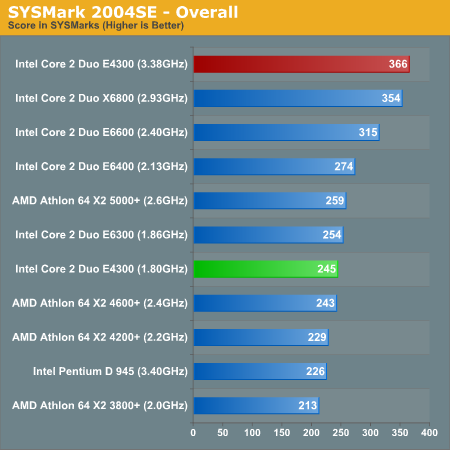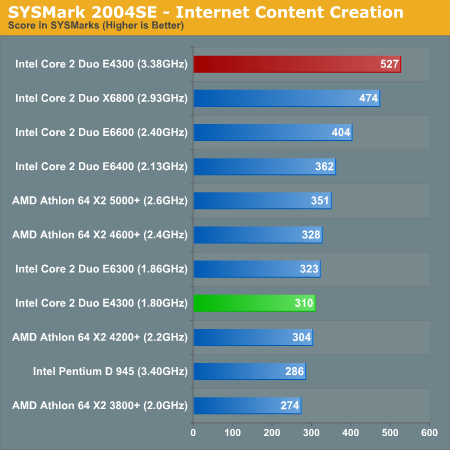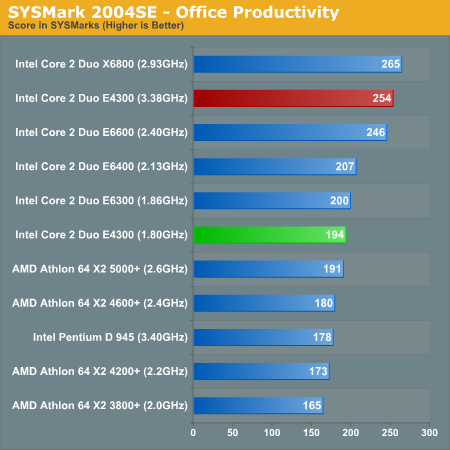Intel Core 2 Duo E4300: Affordable and Highly Overclockable
by Anand Lal Shimpi on January 10, 2007 2:45 AM EST- Posted in
- CPUs
General Performance
Overall system performance, measured using SYSMark 2004SE, places the default clocked E4300 at within 4% of the performance of the E6300. Obviously the release of the E6320 will widen this gap but E6300-level performance is nothing to balk at, given the price point of this chip what we're looking at is nothing short of stellar.

Overclocked, the E4300 truly shines - outpacing the X6800 by a marginal 3.3%. The margin of victory is well within the variance for SYSMark but the point to take home is that we're looking at an overclocked $163 chip, delivering performance equal to a CPU priced at six times its cost.
Internet Content Creation performance reflects what we saw in the overall score - the E4300 is within striking distance of the E6300, and of course faster than AMD's Athlon 64 X2 3800+. When overclocked, the E4300 can give you better performance than a X6800, this time coming in 11% faster.

The Office Productivity suite changes things a bit; while the E4300 continues to perform similarly to the E6300, when overclocked it's still slower than the X6800 despite the clock speed advantage. There are many applications and usage models that will end up favoring more cache over a higher clock speed, and that's where the E4300 will lose out to its more expensive alternatives. At the end of the day, it's still a great value, but keep in mind that the smaller cache will limit maximum performance in some areas.











68 Comments
View All Comments
hubajube - Wednesday, January 10, 2007 - link
Nice OC and I might consider this instead of a E6400. I'll have to wait how the 4MB versions stack up. Also, I'd like to see how it OC's on a Nvidia chipset board. No DS3 for me.tuteja1986 - Wednesday, January 10, 2007 - link
SameIntelUser2000 - Wednesday, January 10, 2007 - link
The 4MB cache and faster FSB is good for performance, but also for raising stock performance from Intel's point of view. The extra cache and more bandwidth enables Core 2 Duo to scale better than the ones that don't. I would like to see E4300 at 800MHz FSB and clocked to say even E6600 speeds to see how it scales but I am expecting too much :P.E4300 at 3.38GHz has an FSB of 1500MHz, which is 40% more than the stock X6800.
IntelUser2000 - Wednesday, January 10, 2007 - link
From the idle power consumption measurements, it seems to use the new Core 2 Duo steppings that has C1E power consumption of 12W. You can see 8W difference from the normal Core 2 Duos, which are at 20W-22W(20W for E6700 and 22W for others).Goty - Wednesday, January 10, 2007 - link
Yeah, but that doesn't matter to 99% of the desktop consumer market. Most only care about power consumption at full load as it is usually a good indication of heat output.hubajube - Wednesday, January 10, 2007 - link
The only people that care about power consumption are geeks and corporate IT departments. Joe SixPack doesn't know and doesn't care. All they want is a machine that does email, stores porn, and surfs the web. You guys need to get out more often.Xentropy - Wednesday, January 10, 2007 - link
You can be sure even Joe SixPack will notice if turning on his PC sounds like a jet engine starting up, though, and higher power consumption means louder cooling solutions.hubajube - Thursday, January 11, 2007 - link
J6P still won't notice because they usually buy low rent Dell's and HP's not, custom built jobs like we have. Like I said, power consumption means nothing to regular computer buyers.